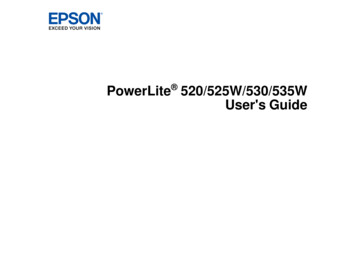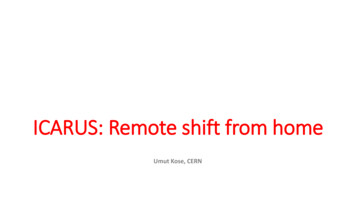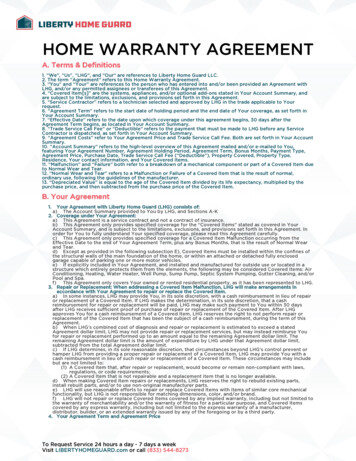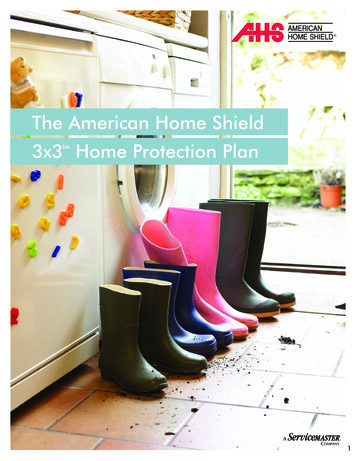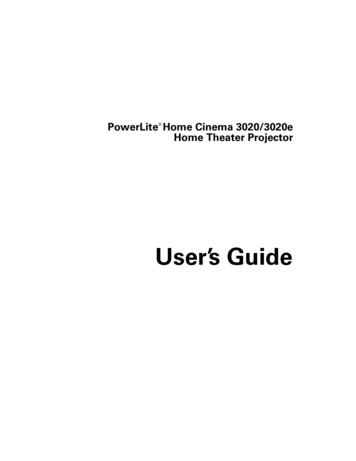
Transcription
PowerLite Home Cinema 3020/3020eHome Theater ProjectorUser’s Guide
ContentsIntroductionProjector PartsRemote Control – PowerLite Home Cinema 3020Remote Control – PowerLite Home Cinema 3020eWirelessHD Transmitter – PowerLite Home Cinema 3020eOptional AccessoriesRegistration and WarrantyUsing This ManualSetting Up the ProjectorChoose a LocationInstalling the ProjectorConnecting the CablesConnecting Video and Computer EquipmentMaking Other ConnectionsInstalling Batteries in the Remote ControlCharging the 3D GlassesTurning the Projector On and OffTurning On the ProjectorTurning Off the ProjectorSelecting the Image SourcePositioning the ImageMaking Basic AdjustmentsFocusing and ZoomingChoosing the Aspect RatioViewing 3D imagesProjecting in Split Screen modeStarting a 5262627292930313335
Choosing Slideshow OptionsChoosing the Color ModeAdvanced Color AdjustmentsAdjusting the Gamma SettingAdjusting RGBCMYLocking the Projector363738394040Making Detailed 757Using the Menu SystemChanging How the Menus DisplayAdjusting the Picture QualityInput Brightness SettingsSharpness and Picture Quality SettingsColor Settings3D SetupAdjustments for Computer ImagesWirelessHD Settings (PowerLite Home Cinema 3020e only)Split Screen SetupSelecting Memory Settings and Resetting the ProjectorCreating Memory SettingsSelecting Memory SettingsRenaming Memory SettingsDeleting Saved Memory SettingsResetting the ProjectorCustomizing Projector FeaturesImage SizingScreen OptionsOther Setup OptionsContents3
Using WirelessHDPlacing the WirelessHD TransmitterConnecting the WirelessHD TransmitterViewing WirelessHD ContentSwitching WirelessHD SourcesUsing Picture-in-PictureUsing HDMI LinkSetting Up HDMI LinkChanging HDMI Link SettingsMaintenanceCleaning the LensCleaning the 3D GlassesCleaning the Projector CaseCleaning and Replacing the Air FilterReplacing the LampResetting the Lamp Usage TimerChecking the Projector StatusStoring the ProjectorTransporting the ProjectorProblem SolvingWhat To Do When the Lights Come On or FlashSolving Picture ProblemsSolving Remote Control ProblemsSolving WirelessHD Problems (PowerLite Home Cinema 3020e Only)Where to Get 6777779838485
SpecificationsGeneralLampRemote ControlWirelessHD Transmitter (Home Cinema 3020e ible Video FormatsESC/VP21 Command CodesNoticesImportant Safety InformationFCC Compliance StatementCopyright NoticeA Note Concerning Responsible Use of Copyrighted 596Contents5
IntroductionThe PowerLite Home Cinema 3020/3020e projector lets you enjoy theater-quality 2D and3D images in the relaxing environment of your own home. Designed especially for homecinema use, it offers these outstanding features:6 Native 1080p (1920 1080) resolution, dynamic contrast ratio up to 40,000:1 and up to2200 lumens of brightness (white light output) for incredibly rich, sharp images in anyroom lighting Auto Iris system that constantly controls the light output based on the gamma andblack/white levels of your projected content, for perfectly adjusted images and deepestblacks Epson C2FineTM 3LCD technology for reliable picture quality, increased contrast ratioand uniform colors 10-bit color quality for unmatched color accuracy, with over a billion colors available HDMI (High-Definition Multimedia Interface ) ports for superior, uncompresseddigital video True 16:9 wide-format projection Powerful 10 W per channel stereo system with two speakers Flexible setup configurations, including front projection and ceiling mounted, withhorizontal keystone slider for offset placementIntroduction
Projector PartsFrontHorizontal keystone sliderControl panelLamp coverZoom ringFocus ringAir exhaustRemote receiverAir filter coverLens coverAir intakeAdjustable footBackCable clip holeCable clip holeHDMI portsPC portUSB portSpeakersVideo portPower inletRS-232C portRemote receiverKensington lock portComponent portAudio (L-R) portIntroduction7
BottomMounting bracketattachment pointsFront adjustable feetProjector Control PanelVolume/horizontalkeystone buttonsBrightnesssensorEscape buttonPowerlightVerticalkeystonebuttonsPower buttonSource buttonLamplight8IntroductionTemperaturelight
Remote Control – PowerLite Home Cinema 3020Standby buttonTurns projector offOn buttonTurns projector onHDMI Link buttonEnables and disables theHDMI link function2D/3D buttonTogglesbetween 2D and3D projectionSplit buttonToggles the SplitScreen function on oroffSource buttonsSwitch between equipmentconnected to the projectorHDMI Link control buttonsControl playback of a linkedvideo deviceMenunavigationbuttonsColor Mode buttonQuickly change color settingsto match room lightingSuper-res buttonAdjusts the Super-res settingon or offDefault buttonResets menuselection to defaultvaluesAspect buttonChanges the picture’s aspect ratioMenu buttonDisplays the projector’smenusRGBCMY buttonDisplays the color adjustment menuAuto Iris buttonToggles the Auto Irisfunction on or off3D Format buttonAdjusts the 3DFormat settingIllumination buttonLights the remote controlbuttons for easy viewingFrame int settingAdjusts the Frame InterpolationsettingMemory buttonAccesses the memory menuBlank buttonTemporarily stops projection orhides the menu screenIntroduction9
Remote Control – PowerLite Home Cinema 3020eOn buttonTurns projector onStandby buttonTurns projector offSource buttonsSwitch between equipmentconnected to the projectorSplit buttonToggles the SplitScreen function on oroffHDMI Link buttonEnables and disables theHDMI link functionHDMI Link control buttonsControl playback of a linkedvideo device2D/3D buttonTogglesbetween 2D and3D projectionColor Mode buttonQuickly change color settingsto match room lightingMenunavigationbuttonsSuper-res buttonAdjusts the Super-res settingon or offDefault buttonResets menuselection to defaultvaluesAspect buttonChanges the picture’s aspect ratioMenu buttonDisplays the projector’smenusRGBCMY buttonDisplays the color adjustment menuFrame Int buttonAdjusts the Frame InterpolationsettingAuto Iris buttonToggles the Auto Irisfunction on or offMemory buttonAccesses thememory menu10IntroductionIllumination buttonLights the remote controlbuttons for easy viewingWirelessHDTransmittercontrolsBlank buttonTemporarily stops projection orhides the menu screen
WirelessHD Transmitter – PowerLite Home Cinema 3020eFrontPower buttonInput buttonOutput buttonPower switchPower lightWiHD lightLink lightSetup/Reset button(bottom of transmitter)Back3D glasses charging portHDMI input portsHDMI output portOptical Audio Out portAC adapter portIntroduction11
Optional AccessoriesEpson provides the following optional accessories for the projector:ProductPart numberReplacement lampV12H010L68Air filter replacementV13H134A38Kensington security lock (anti-theft device)ELPSL01Projector mountCHF1000Computer cable (6 feet [1.8 meters])V12H005C02RF 3D Active Shutter GlassesV12H548006PixiePlus control system for Epson projectorsELPSP10Belkin Pro Series VGA / SVGA cable – 6 ftF3H982-06Belkin PureAV HDMI audio video cable – 3 ftAV22300-03In addition to the accessories listed above, 1-year and 2-year extended service plans areavailable. You can purchase these plans and other accessories from an authorized Epsonreseller. To find the nearest reseller, please call 800-GO-EPSON (800-463-7766). Topurchase online, visit www.epsonstore.com (U.S. sales) or www.epson.ca (Canadian sales).Registration and WarrantyYour projector comes with a basic two-year carry-in warranty for the projector, one-year 3Dglasses warranty, and a 90 day limited warranty for the lamp. For details, see the Quick Setupsheet or warranty booklet.In addition, Epson offers free Extra CareSM Home Service. In the unlikely event of anequipment failure, you won’t have to wait for your unit to be repaired. Instead, Epson willship you a replacement unit anywhere in the United States, Canada, or Puerto Rico. See yourExtra Care Home Service brochure for details.To register, simply follow the registration instructions on the CD, or register online atepson.com/webreg. Registering also lets you receive special updates on new accessories,products, and service.12Introduction
Using This ManualThis book contains all the information you need to use the projector, in addition to basicsetup and maintenance instructions, troubleshooting tips, important safety instructions,specifications, and warranty information.Please follow these guidelines as you read through the manual:Warning: Must be followed carefully to avoid bodily injury.Caution: Must be observed to avoid damage to your equipment.Note: Contains important information about your projector.Tip: Contains helpful projection tips.Need additional help? Take advantage of Epson’s automated support services 24 hours a dayat epson.com/support (U.S.) or epson.ca/support (Canada). Use this site to view FAQs orproduct information and e-mail Epson.If you need more help, you can use the Epson PrivateLine Support service by calling(800) 637-7661.Introduction13
Setting Up the ProjectorFollow the instructions in this section to choose a location for the projector, connect thecables, and display an image.Choose a LocationYou can install the projector for the viewing setups shown below, as well as rear projection.CenterCeiling14Setting Up the Projector
Keep the projector level and place it at a height so its lens is even with the top or the bottomof the screen and is centered horizontally. If this isn’t possible, use the horizontal keystoneslider and vertical keystone buttons to adjust the image (see page 27).Note: Image quality is reduced if keystone correction is used. For the best possible image quality,avoid using keystone correction.Diagonal image sizeProjection distanceOffsetOffset refers to distance frombottom of image to center oflens.The size of the image is determined by the distance from the projector’s lens to the screen.Depending on your display settings and how you use the zoom ring, the actual size may differ.Use these tables as a guide for projector placement:16:9 aspect ratioProjection distanceDiagonal image size(width height)Offset3.8 to 6.2 feet116 to 190 cm40 in. (35 20 in.)101.6 cm (89 50 cm)0.1 in.(0 cm)5.8 to 9.4 feet176 to 287 cm60 in. (51 30 in.)152.4 cm (130 75 cm)0.1 in.(0 cm)7.7 to 12.6 feet235 to 383 cm80 in. (71 39 in.)203.2 cm (180 100 cm)0.1 in.(0 cm)9.7 to 15.7 feet295 to 480 cm100 in. (87 47 in.)254 cm (220 120 cm)0.1 in.(0 cm)11.6 to 18.9 feet354 to 576 cm120 in. (106 59 in.)304.9 cm (270 150 cm)0.1 in.(0 cm)14.6 to 23.7 feet444 to 721 cm150 in. (130 75 in.)361 cm (330 190 cm)0.2 in.(1 cm)17.5 to 28.4 feet533 to 866 cm180 in. (173 98 in.)457 cm (440 250 cm)0.3 in.(1 cm)Setting Up the Projector15
4:3 aspect ratioProjection distanceDiagonal image size(width height)Offset4.7 to 7.6 feet143 to 233 cm40 in. (32 24 in.)101.6 cm (81 61 cm)0.1 in.(0 cm)7.1 to 11.5 feet216 to 352 cm60 in. (47 35 in.)152.4 cm (120 90 cm)0.1 in.(0 cm)9.5 to 15.4 feet289 to 470 cm80 in. (63 47 in.)203.2 cm (160 120 cm)0.1 in.(0 cm)11.8 to 19.3 feet361 to 588 cm100 in. (79 59 in.)254 cm (200 150 cm)0.2 in.(0 cm)14.2 to 23.2 feet434 to 706 cm120 in. (94 71 in.)304.8 cm (240 180 cm)0.2 in.(0 cm)17.8 to 29 feet544 to 883 cm150 in. (118 91 in.)381 cm (300 230 cm)0.3 in.(1 cm)23.8 to 38.7 feet726 to 1179 cm200 in. (161 118 in.)508 cm (410 300 cm)0.3 in.(1 cm)To determine the exact image size when you know the projection distance (or the exactprojection distance when you know the desired image size), you can use the Image SizeCalculator. This program is available on the Epson website at epson.com/support (U.S.) orepson.ca/support (Canada).Also keep these considerations in mind:16 Make sure there is plenty of space for ventilation around and under the projector. Do notset the projector on top of loose materials that could block the vents underneath. Make sure the projector is within 9.8 feet (3 m) of a grounded electrical outlet orextension cord.Setting Up the Projector
In order to view 3D images correctly, 3D glasses must be worn within 32 feet (10 m) of theprojector. Use the image below to determine the viewing distance for 3D projection (theshading represents the 3D viewing area):Installing the ProjectorTo install the projector, you first need to determine the location, based on the size of yourscreen (maximum diagonal image size). Use the tables on page 15 as a guide to positioning theprojector.To suspend the projector from a ceiling, you will need the optional projector mount designedfor the projector. See page 12 for ordering information. Follow the instructions included withthe mount to install the projector.Warning: When installing or adjusting the ceiling mount, do not use adhesives to prevent thescrews from loosening and do not use any type of oil or lubricant. These may cause the projectorcasing to crack and the projector may fall, causing serious injury and serious damage to theprojector.If you install the projector on the ceiling, you will need to invert the picture so that it appearsright side up. Follow these steps:1. Press the Menu button on the remote control.2. Open the Settings menu, then select Projection.3. Select Front/Ceiling.4. Press the Menu button to exit the menu system.Setting Up the Projector17
The following illustrations show the dimensions of the projector:16.5 in. (420 mm)8.3 in. (210 mm)Center of lens5.5 in.(139.6 mm)3.2 in.(80 mm)11.8 in. (300 mm)2.4 in.(60 mm)5.9 in. (150 mm)2.8 in.(70 mm)14.4 in.(365 mm)6.3 in.(160 mm)18Setting Up the Projector
Connecting the CablesConnecting Video and Computer EquipmentYou can connect the projector to many types of video equipment, such as a Blu-rayDisc /DVD player, digital tuner, cable or satellite box, video game console, camcorder, ordigital camera. You can also connect it to a desktop or laptop PC or Apple Mac system. Fordetails on compatible video formats, see page 89.To remove the interface cover and connect cables to the back of the projector (PowerLiteHome Cinema 3020e only), grip the cover at the gaps on the bottom of the cover and pullupwards. Swing the cover out from the projector, then pull the cover straight out to detach it.Note: If you have trouble gripping the gaps on the bottom of the cover, use a flat object, such asa coin, to help open the cover.To reattach the cover, insert the tabs at the top of the cover into the projector, then snap thebottom of the cover into place.Setting Up the Projector19
You can connect up to five pieces of equipment directly to the projector at the same time,using any of the commercially available cables shown below:Note: See page 57 for information on connecting with WirelessHD (PowerLite Home Cinema3020e only).Port nameVideo equipment connectionHDMI 1/HDMI 2Use a High Speed HDMI cable:ComponentUse a component video cable(with RCA-style connectors):Computer connection—Connect the cable to the threecomponent video ports. Matchcorresponding colors between thecable and the ports. For audio, use astereo RCA audio cable:PC—Use a Mini D-sub, 15-pin monitor cableto connect to a computer RGB(monitor) port:For audio, use a stereo RCA tomini-jack stereo (3.5 mm) audio cable:VideoUse an RCA video and audio cable:—For best results, connect your video equipment to the HDMI port, if possible. If yourequipment doesn’t support HDMI, connect it to either the Component (for high quality,component video) or Video (for composite video) port.20Setting Up the Projector
When you connect an HDMI cable to the projector, it is recommended that you fasten itwith the included cable clip. Follow these steps to install the cable clip:1. Connect the HDMI cable to one of the HDMI ports on the projector.2. Insert the end of the cable clip anchor into the cable clip hole near the HDMI port, asshow below.3. Place the open cable clip around the HDMI cable, but don’t lock it into place.4. Slide the cable clip towards the projector and lock the clip onto the HDMI connector.To remove the cable clip, unlock the clip and disconnect the HDMI cable. Then pinch theside of the cable clip anchor and carefully pull it out of the cable clip hole.Setting Up the Projector21
Making Other ConnectionsConnect the power cable and other cables described below, depending on how you plan touse the projector.22 Plug the power cable into the projector and a grounded electrical outlet. To use an AV controller with the projector, connect a 9-pin null modem serial cable tothe RS-232C port. To connect to a digital camera, flash drive, or storage device, connect the USB cable thatcame with your device to both your device and to the projector’s USB port. Forinformation on using the projector’s Slideshow feature, see page 35.Setting Up the Projector
Installing Batteries in the Remote ControlThe remote control uses two AA batteries.Warning: Keep batteries away from children. If a battery is swallowed, contact your doctorimmediately.1. Release the tab and lift open the cover.2. Insert two new AA batteries as shown.3. Insert the tab on the cover and press it down until it clicks intoplace.Aim the remote control at the screen, or at the front or back of theprojector. Make sure you are within 32 feet (10 meters) of the projector.If you suspect the batteries are weak, press theillumination button. Ifthe buttons do not glow, check the battery orientation or replace thebatteries.Charging the 3D GlassesIf you are using Epson RF 3D Active Shutter Glasses, follow these steps to charge the glasses:1. Plug a USB cable into the port on the bridge of the glasses.Setting Up the Projector23
2. Do one of the following: Plug the other end of the USB cable into the USB to AC adapter (PowerLite HomeCinema 3020 only), then connect the adapter to a wall outlet. Plug the other end of the USB cable into the 3D glasses charging port on the side ofthe WirelessHD Transmitter (PowerLite Home Cinema 3020e only). Plug the other end of the USB cable into the USB-A port on the back of theprojector.Note: The projector must be turned on to charge the 3D glasses through the USB port.24Setting Up the Projector
Plug the other end of the USB cable into a computer or other device with an availableUSB port.Note: Epson does not guarantee the compatibility of the Epson RF 3D active shutter glasseswith computers or other devices.Turning the Projector On and OffTurning On the Projector1. Remove the lens cap.2. Turn on any connected equipment you plan to use.3. Press the On button on the remote control or thePpower button on the projector.Remote controlProjectorNote: To prevent children from turning on the projector, you can use the Child Lock feature. Seepage 40 for details.If you’ll be using the projector at an altitude above 4921 feet (1500 meters), turn on High AltitudeMode so the fan can properly cool the projector at the high altitude air pressure. See page 59 fordetails.The power light flashes while the projector warms up. If you don’t see a picture, you mayneed to change the image source as described on page 26.Setting Up the Projector25
Turning Off the Projector1. Turn off any equipment connected to the projector.2. Press the Ppower button on the projector twice or press the Standby button on theremote control and wait for the light to stop flashing.Caution: Turn off this product when not in use to prolong the life of the projector.Selecting the Image SourceThe source buttons on the projector and remote control let you switch between images fromdifferent pieces of equipment connected to the projector (such as a Blu-ray Disc/DVD player,cable or satellite box, or video game console).Press the Source button on the remote control that corresponds to the port to which yourvideo source
Menu button Displays the projector’s menus Default button Resets menu selection to default values 2D/3D button Toggles between 2D and 3D projection RGBCMY button Displays the color adjustment menu Memory button Accesses the memory menu HDMI Link control buttons Control playback of a linked video device Super
